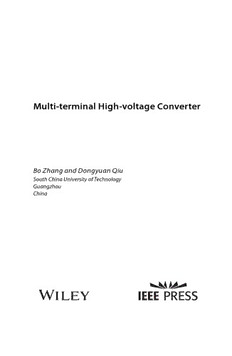
Multi-Terminal High-Voltage Converter PDF
Preview Multi-Terminal High-Voltage Converter
Multi-terminal High-voltage Converter BoZhangandDongyuanQiu SouthChinaUniversityofTechnology Guangzhou China Thiseditionfirstpublished2019 ©2019JohnWiley&SonsSingaporePte.Ltd LibraryofCongressCataloging-in-PublicationData Names:Zhang,Bo,1962October23-author.|Qiu,Dongyuan,author. Title:Multi-terminalhigh-voltageconverter/Prof.BoZhang,Prof.Dongyuan Qiu. Description:Hoboken,NJ:JohnWiley&Sons,2019.|Includes bibliographicalreferencesandindex.| Identifiers:LCCN2018028413(print)|LCCN2018042477(ebook)|ISBN 9781119188360(AdobePDF)|ISBN9781119188353(ePub)|ISBN9781119188339 (hardcover) Subjects:LCSH:Electriccurrentconverters.|Electricpower distribution–Hightension.|Electricpowerdistribution–Directcurrent. |Electricpowerdistribution–Alternatingcurrent. Classification:LCCTK2796(ebook)|LCCTK2796.Z42332018(print)|DDC 621.31/3–dc23 LCrecordavailableathttps://lccn.loc.gov/2018028413 Setin10/12ptWarnockProbySPiGlobal,Chennai,India Contents Preface xiii 1 OverviewofHigh-voltageConverters 1 1.1 Introduction 1 1.2 ClassificationofHigh-voltageHigh-PowerConverters 5 1.2.1 Two-LevelConverters 5 1.2.2 MultilevelConverters 7 1.3 TopologiesofMultilevelConverters 8 1.3.1 Neutral-PointClampedConverter 8 1.3.2 FlyingCapacitorConverter 10 1.3.3 CascadedH-bridgeConverter 11 1.3.4 ModularMultilevelConverter 13 1.3.5 ActiveNeutral-PointClampedConverter 16 1.3.6 HybridMultilevelConverters 19 1.4 ModulationMethodsofMultilevelConverter 22 1.4.1 Space-VectorModulation 24 1.4.2 MulticarrierPulse-WidthModulation 24 1.4.3 SelectiveHarmonicEliminationModulation 25 1.4.4 Nearest-LevelControlMethod 26 1.4.5 HybridModulation 27 1.5 ArchitectureofMulti-terminalHigh-voltageConverter 27 1.6 ArrangementofthisBook 31 References 32 2 Multiple-Bridge-ModuleHigh-voltageConverters 35 2.1 Introduction 35 2.2 ConfigurationofBridgeModule 35 2.2.1 Half-BridgeModule 36 2.2.2 Full-BridgeModule 37 2.3 Single-PhaseHalf-Bridge-ModuleHigh-voltageConverter 39 2.3.1 BasicStructureandOperatingPrinciple 39 2.3.2 ControlScheme 41 2.3.3 OutputVoltageVerification 43 2.3.4 SimplifiedSingle-PhaseHalf-BridgeModule 43 2.4 Three-PhaseHalf-Bridge-ModuleHigh-voltageConverter 45 2.4.1 BasicStructureandOperatingPrinciple 45 2.4.2 ControlScheme 47 2.4.3 OutputVoltageVerification 49 2.5 Three-PhaseFour-LegHalf-Bridge-ModuleHigh-voltageConverter 51 2.6 Full-Bridge-ModuleHigh-voltageConverter 51 2.7 AdvantagesofMultiple-Bridge-ModuleConverter 53 2.8 Summary 54 References 54 3 Single-InputMultiple-OutputHigh-voltageDC–ACConverters 55 3.1 Introduction 55 3.2 Single-InputDual-OutputHalf-BridgeSingle-PhaseDC–ACConverter 55 3.2.1 BasicStructureandOperatingPrinciple 55 3.2.2 ControlScheme 57 3.2.3 OutputVoltageVerification 59 3.3 Single-InputDual-OutputFull-BridgeSingle-PhaseDC–ACConverter 60 3.3.1 BasicStructureandOperatingPrinciple 60 3.3.2 ControlScheme 62 3.3.3 OutputVoltageVerification 62 3.4 Single-InputDual-OutputThree-PhaseDC–ACConverter 64 3.4.1 BasicStructureandOperatingPrinciple 64 3.4.2 ControlScheme 64 3.4.3 OutputVoltageVerification 66 3.5 Single-InputMultiple-OutputHalf-BridgeSingle-PhaseDC–AC Converter 67 3.5.1 BasicStructureandOperatingPrinciple 67 3.5.2 ControlScheme 69 3.5.3 OutputVoltageVerification 70 3.6 Single-InputMultiple-OutputFull-BridgeSingle-PhaseDC–AC Converter 72 3.6.1 BasicStructureandOperatingPrinciple 72 3.6.2 ControlScheme 72 3.6.3 OutputVoltageVerification 75 3.7 Single-InputMultiple-OutputThree-PhaseDC–ACConverter 75 3.7.1 BasicStructureandOperatingPrinciple 75 3.7.2 ControlScheme 77 3.7.3 OutputVoltageVerification 77 3.8 Summary 79 References 79 4 Multiple-InputSingle-OutputHigh-voltageAC–DCConverters 81 4.1 Introduction 81 4.2 Single-PhaseThree-ArmDual-InputSingle-OutputAC–DCConverter 81 4.2.1 BasicStructureandOperatingPrinciple 81 4.2.2 ControlScheme 83 4.2.3 PerformanceVerification 84 4.3 Single-PhaseSix-ArmDual-InputSingle-OutputAC–DCConverter 84 4.3.1 BasicStructureandOperatingPrinciple 84 4.3.2 ControlScheme 88 4.3.3 PerformanceVerification 89 4.4 Three-PhaseNine-ArmDual-InputSingle-OutputAC–DCConverter 93 4.4.1 BasicStructureandOperatingPrinciple 93 4.4.2 ControlScheme 93 4.4.3 PerformanceVerification 95 4.5 Single-PhaseM-ArmMultiple-InputSingle-OutputAC–DCConverter 95 4.5.1 BasicStructureandOperatingPrinciple 95 4.5.2 ControlScheme 98 4.5.3 PerformanceVerification 100 4.6 Single-Phase2M-ArmMultiple-InputSingle-OutputAC–DC Converter 100 4.6.1 BasicStructureandOperatingPrinciple 100 4.6.2 ControlScheme 104 4.6.3 PerformanceVerification 105 4.7 Three-Phase3M-ArmMultiple-InputSingle-OutputAC–DC Converter 106 4.7.1 BasicStructureandOperatingPrinciple 106 4.7.2 ControlScheme 106 4.7.3 PerformanceVerification 110 4.8 Summary 110 References 112 5 Multiple-InputMultiple-OutputHigh-voltageAC–ACConverters 113 5.1 Introduction 113 5.2 Single-PhaseSingle-InputSingle-OutputAC–ACConverter 113 5.2.1 BasicStructureandOperatingPrinciple 113 5.2.2 ControlScheme 114 5.2.3 OutputVoltageVerification 117 5.3 Three-PhaseSingle-InputSingle-OutputAC–ACConverter 117 5.3.1 BasicStructureandOperatingPrinciple 117 5.3.2 ControlScheme 118 5.3.3 OutputVoltageVerification 120 5.4 Single-PhaseMultiple-terminalAC–ACConverter 122 5.4.1 BasicStructureandOperatingPrinciple 122 5.4.2 ControlScheme 124 5.4.3 OutputVoltageVerification 125 5.5 Three-PhaseMultiple-terminalAC–ACConverter 125 5.5.1 BasicStructureandOperatingPrinciple 125 5.5.2 ControlScheme 126 5.5.3 OutputVoltageVerification 129 5.6 Summary 133 References 133 6 Multiple-terminalHigh-voltageDC–DCConverters 135 6.1 Introduction 135 6.2 Single-InputDual-OutputDC–DCConverter 135 6.2.1 BasicStructureandOperatingPrinciple 135 6.2.2 ControlScheme 136 6.2.3 SimulationVerification 138 6.3 Single-InputMultiple-OutputDC–DCConverter 138 6.3.1 BasicStructureandOperatingPrinciple 138 6.3.2 ControlScheme 141 6.3.3 SimulationVerification 143 6.4 Multiple-InputMultiple-OutputDC–DCConverter 143 6.5 Summary 146 References 146 7 Multiple-terminalHigh-voltageHybridConverters 147 7.1 Introduction 147 7.2 Six-ArmHybridConverterwithSingle-PhaseACInput 147 7.2.1 BasicStructureandOperatingPrinciple 147 7.2.2 ControlScheme 149 7.2.3 SimulationVerification 151 7.3 Nine-ArmHybridConverterwithThree-PhaseACInput 151 7.3.1 BasicStructureandOperatingPrinciple 151 7.3.2 ControlScheme 152 7.3.3 SimulationVerification 153 7.4 Multiple-ArmHybridConverter 153 7.4.1 BasicStructureandOperatingPrinciple 153 7.4.2 ControlScheme 158 7.5 Summary 159 References 159 8 Short-CircuitProtectionforHigh-voltageConverters 161 8.1 Introduction 161 8.2 ModularDCCircuitBreaker 162 8.3 Sub-ModuleswithDCFault-HandlingCapability 165 8.3.1 Full-BridgeSub-Module 165 8.3.2 Clamp-DoubleSub-Module 166 8.3.3 Unipolar-VoltageSub-Module 167 8.3.4 Cross-ConnectedSub-Module 168 8.3.5 Series-ConnectedDoubleSub-Module 170 8.4 ConfigurationoftheHybridMulti-terminalHigh-voltageConverter 171 8.5 Summary 174 References 175 9 CommonTechniquesandApplicationsofMulti-terminalHigh-voltage Converters 177 9.1 Introduction 177 9.2 CapacitorVoltageControlSchemeforMulti-terminalHigh-voltage Converters 177 9.2.1 Single-InputDual-OutputDC–ACConverter 177 9.2.2 Single-PhaseMultiple-InputSingle-OutputAC–DCConverter 182 9.3 ApplicationsofMulti-terminalHigh-voltageConverter 192 9.3.1 MultipleWindTurbinesandDCBus 192 9.3.2 MultipleWindTurbinesandACBus 196 9.3.3 MultipleACMotorsandDCBus 196 9.3.4 MultipleACMotorsandACBus 196 9.4 Summary 200 References 200 Index 201 Preface Thenoveldesignandinventionofpowerconvertertopologiesarealwaysahotresearch topicinpowerelectronics.Uptonow,therehavebeenthousandsofpowerconverter topologies proposed for different applications. It is found that the majority of these topologies,however,arederivedandimprovedfromthebasicpowerelectronictopolo- gies.IntermsofTRIZ(theoryofthesolutionofinventiveproblems)proposedbythe former Soviet inventor G. S. Altshuller, “the original inventions in any research field takesuponlyfourpercentofall,whiletheremainingninety-sixpercentofinventions aretheapplicationsorcombinationsofthem.”Sincepowerconvertertopologiesdesign belongstotheareaofinvention,itfollowstheTRIZprinciplewithoutexception. ItisknownthatanMMC(modularmultilevelconverter)solvestheproblemofvoltage sharingamongpowerelectronicdevicesunderhighvoltage,whileanine-switchinverter realizesdualinputordualoutputofpowerelectronicconverters.DevelopedfromMMC and the nine-switch converter, and combining the advantages of both, this book pro- posesthemulti-terminalhigh-voltageconverter.Besides,Multi-terminalHigh-voltage Converterhasuniquefeatures,asfollows: 1) It can simultaneously interface with several renewable sources such as hybrid sys- temsofphotovoltaicpowergenerationandwindpowergeneration. 2) Itcansimultaneouslyprovideenergytomultipleloadsandtheloadscanbehybrid systems,includingACandDCloads. 3) ItcanbeappliedtoAC–DC,DC–AC,DC–DC,andAC–ACunitsandsomecombi- nationsaswellasconversionsofthem. 4) Itcanformanovelhigh-voltageAC/DCtransmissionnetworkandimprovetheper- formanceofsmartgrids. Thisbooksummarizesourachievementswithpowerconvertertopologiesinthepast 10years.Wehopethatitwillprovidenewideasforthetopologicalinventionofpower electronicconverters,andhelpresearchersandengineersworkingonpowerelectronics andsmartgridstoapplythesetopologiestoAC/DCpowertransmissionasaguide. March2018 BoZhangandDongyuanQiu SouthChinaUniversityofTechnology Guangzhou,China 1 1 OverviewofHigh-voltageConverters 1.1 Introduction Withthedevelopmentoflarge-scaledistributedgeneration(DG)systemsaccess,such asphotovoltaic(PV)panels,windturbines,energystoragedevices,andelectricvehicles, thestructureandfeaturesofpowergridsareboundtochange,whichwillbringabout not only a series of impacts on the safe and stable operation of power grids, but also challengesforensuringpowersupplyreliabilityandpowerquality. InthetraditionalpowergridshowninFigure1.1a,thepowerflowisunidirectionalin thepowergeneration,transmission,substation,distribution,supply,andothersectors. Sincethepenetrationrateofsmall-scalePVpanels,electricvehiclechargingstations, and energy storage stations is increasing in the power distribution side, as a result, the electric power is allowed to flow bidirectionally in the smart grid, as shown in Figure1.1b. Asasmartgridisessentiallydifferentfromatraditionalpowergrid,thedevelopment ofsmartgridsprovidesagreatopportunitytointerconnectdifferentkindsofDGsys- temswiththegrid.Inordertoachieveabidirectionalflowofelectricityandensurethe powerqualityofthegrid,thepowerelectronicconvertermusthavegoodperformanceas aninterfacebetweentheDGsystemandthepowergrid.Sinceamultilevelconvertercan extendthewell-knownadvantagesoflow-andmedium-powerpulse-widthmodulation (PWM)convertertechnologyintohigh-voltagehigh-powerapplications,itbecomesthe firstchoiceforgrid-connectedinterfaceconvertersandplaysanimportantroleinthe followingthreeaspectsofsmartgrids: 1) Power generation side. The DC power generated by the large-scale PV station can beconvertedtoACpowerandtransferredtothegridbyamultilevelconverter.The ACpowerfromlargewindfarmscanbeconvertedintostableACpowerandthen connectedtothegridbyatwo-stagemultilevelconverter.Large-scalestorageplants cansupplypowertothegridandbechargedbythegridviaabidirectionalmultilevel converter. 2) Power transmission side. High-voltage direct current (HVDC) power transmission associated with flexible alternating current transmission (FACT) are considered the most promising transmission technologies in smart grids. Since high-voltage high-power power conversion is often required, both HVDC and FACT systems were based initially on thyristor technology and more recently on fully controlled semiconductorsandvoltage-sourcemultilevelconvertertopologies. Electric vehicles Industrial users Residential users Power generation Transmission Substation (a) Commercial users Figure1.1Schematicofpowergrid.(a)Traditionalpowergrid.(b)Smartgrid.
